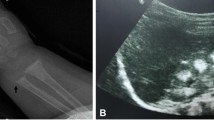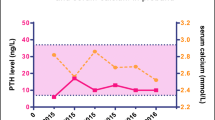Abstract
Mutations of the CYP24A1 gene, encoding for the enzyme 25(OH)D-24-hydroxylase, can cause hypercalcemia, hypercalciuria, nephrolithiasis and nephrocalcinosis. We report the case of a 22-year-old male patient with recurrent nephrolithiasis, nephrocalcinosis, hypercalcemia with low parathyroid hormone levels, hypercalciuria and low bone mass. Gene sequencing showed that the patient had compound heterozygous mutations including a novel genotype of the CYP24A1 gene. Genetic CYP24A1 testing and biochemical analyses were offered to other family members; the father was heterozygous for the same novel genotype and was also affected with recurrent nephrolithiasis.

Similar content being viewed by others
References
Tebben PJ, Milliner DS, Horst RL et al (2012) Hypercalcemia, hypercalciuria, and elevated calcitriol concentrations with autosomal dominant transmission due to CYP24A1 mutations: effects of ketoconazole therapy. J Clin Endocrinol Metab 97(3):E423–E427
Schlingmann KP, Kaufmann M, Weber S et al (2011) Mutations in CYP24A1 and idiopathic infantile hypercalcemia. N Engl J Med 365(5):410–421
Streeten EA, Zarbalian K, Damcott CM (2011) CYP24A1 mutations in idiopathic infantile hypercalcemia. N Engl J Med 365(18):1741–1743
Dauber A, Nguyen TT, Sochett E et al (2012) Genetic defect in CYP24A1, the vitamin D 24-hydroxylase gene, in a patient with severe infantile hypercalcemia. J Clin Endocrinol Metab 97(2):E268–E274
Castanet M, Mallet E, Kottler M-L (2013) Lightwood syndrome revisited with a novel mutation in CYP24 and vitamin D supplement recommendations. J Pediatr 163(4):1208–1210
Meusburger E, Mündlein A, Zitt E, Obermayer-Pietsch B, Kotzot D, Lhotta K (2013) Medullary nephrocalcinosis in an adult patient with idiopathic infantile hypercalcaemia and a novel CYP24A1 mutation. Clin Kidney J 6(2):211–215
Fencl F, Bláhová K, Schlingmann KP, Konrad M, Seeman T (2013) Severe hypercalcemic crisis in an infant with idiopathic infantile hypercalcemia caused by mutation in CYP24A1 gene. Eur J Pediatr 172(1):45–49
Dinour D, Beckerman P, Ganon L, Tordjman K, Eisenstein Z, Holtzman EJ (2013) Loss-of-function mutations of CYP24A1, the vitamin D 24-hydroxylase gene, cause long-standing hypercalciuric nephrolithiasis and nephrocalcinosis. J Urol 190(2):552–557
Nesterova G, Malicdan MC, Yasuda K et al (2013) 1,25-(OH)2D-24 hydroxylase (CYP24A1) deficiency as a cause of nephrolithiasis. Clin J Am Soc Nephrol CJASN 8(4):649–657
Colussi G, Ganon L, Penco S et al (2014) Chronic hypercalcaemia from inactivating mutations of vitamin D 24-hydroxylase (CYP24A1): implications for mineral metabolism changes in chronic renal failure. Nephrol Dial Transplant Off Publ Eur Dial Transpl Assoc—Eur Ren Assoc 29(3):636–643
Jacobs TP, Kaufman M, Jones G et al (2014) A lifetime of hypercalcemia and hypercalciuria, finally explained. J Clin Endocrinol Metab 99(3):708–712
Wolf P, Müller-Sacherer T, Baumgartner-Parzer S et al (2014) A case of “late-onset” idiopathic infantile hypercalcemia secondary to mutations in the CYP24A1 gene. Endocr Pract Off J Am Coll Endocrinol Am Assoc Clin Endocrinol 20(5):e91–e95
Dowen FE, Sayers JA, Hynes AM, Sayer JA (2014) CYP24A1 mutation leading to nephrocalcinosis. Kidney Int 85(6):1475
Figueres M-L, Linglart A, Bienaime F et al (2015) Kidney function and influence of sunlight exposure in patients with impaired 24-hydroxylation of vitamin D due to CYP24A1 mutations. Am J Kidney Dis Off J Natl Kidney Found 65(1):122–126
Molin A, Baudoin R, Kaufmann M et al (2015) CYP24A1 mutations in a cohort of hypercalcemic patients: evidence for a recessive trait. J Clin Endocrinol Metab 100(10):E1343–E1352
Cools M, Goemaere S, Baetens D et al (2015) Calcium and bone homeostasis in heterozygous carriers of CYP24A1 mutations: a cross-sectional study. Bone 81:89–96
Ketha H, Kumar R, Singh RJ (2016) LC-MS/MS for identifying patients with CYP24A1 mutations. Clin Chem 62(1):236–242
O’Keeffe DT, Tebben PJ, Kumar R, Singh RJ, Wu Y, Wermers RA (2016) Clinical and biochemical phenotypes of adults with monoallelic and biallelic CYP24A1 mutations: evidence of gene dose effect. Osteoporos Int 1–15. doi:10.1007/s00198-016-3615-6
Gigante M, Santangelo L, Diella S et al (2016) Mutational spectrum of CYP24A1 gene in a cohort of Italian patients with idiopathic infantile hypercalcemia. Nephron 133(3):193–204
Halbritter J, Baum M, Hynes AM et al (2015) Fourteen monogenic genes account for 15 % of nephrolithiasis/nephrocalcinosis. J Am Soc Nephrol 26(3):543–551
St-Arnaud R, Arabian A, Travers R et al (2000) Deficient mineralization of intramembranous bone in vitamin D-24-hydroxylase-ablated mice is due to elevated 1,25-dihydroxyvitamin D and not to the absence of 24,25-dihydroxyvitamin D. Endocrinology 141(7):2658–2666
Author information
Authors and Affiliations
Corresponding author
Ethics declarations
Conflict of interest
All authors declare no conflict of interest.
Ethical approval
All procedures performed in studies involving human participants were in accordance with the ethical standards of the institutional and/or national research committee and with the 1964 Helsinki declaration and its later amendments or comparable ethical standards.
Informed consent
Informed consent was obtained from all individual participants included in the study.
Additional information
An erratum to this article is available at http://dx.doi.org/10.1007/s00240-016-0940-3.
Rights and permissions
About this article
Cite this article
Ferraro, P.M., Minucci, A., Primiano, A. et al. A novel CYP24A1 genotype associated to a clinical picture of hypercalcemia, nephrolithiasis and low bone mass. Urolithiasis 45, 291–294 (2017). https://doi.org/10.1007/s00240-016-0923-4
Received:
Accepted:
Published:
Issue Date:
DOI: https://doi.org/10.1007/s00240-016-0923-4




